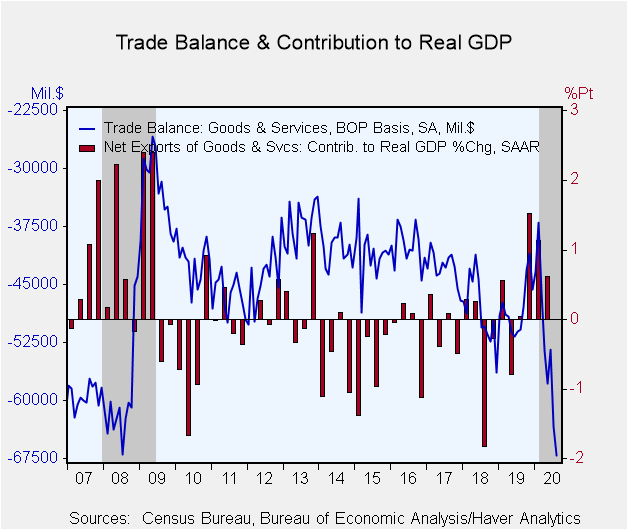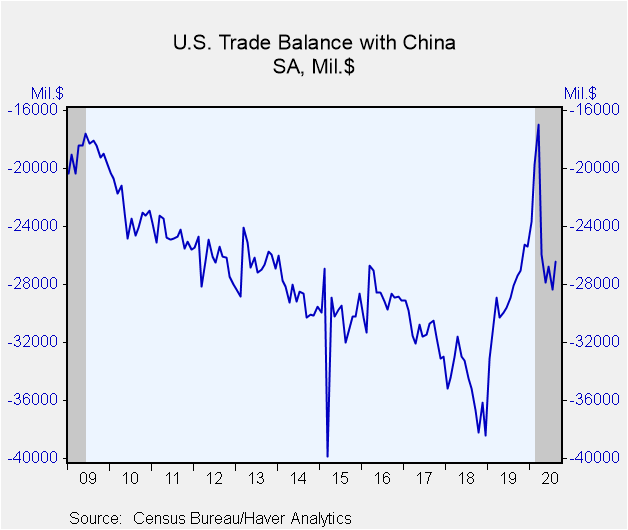 Global| Oct 06 2020
Global| Oct 06 2020U.S. Trade Deficit Widened Further in August
by:Sandy Batten
|in:Economy in Brief
Summary
• Both exports and imports increase. • Real trade balance also widened, points to meaningful drag on Q3 GDP. The U.S. trade deficit in goods and services widened further in August to $67.1 billion from $63.4 billion in July (revised [...]
• Both exports and imports increase.
• Real trade balance also widened, points to meaningful drag on Q3 GDP.
The U.S. trade deficit in goods and services widened further in August to $67.1 billion from $63.4 billion in July (revised from $63.6 billion). A $66.0 billion deficit had been expected in the Action Economics Forecast Survey. Exports increased 2.2% m/m (-18.3% y/y), a slowdown from 9.6% m/m and 8.3% m/m jumps in June and July, respectively. Imports rose 3.2% m/m (-8.5% y/y) following a 10.9% m/m surge in July as the economy continued to rebound from the coronavirus shutdown.
The nominal deficit in goods trade widened to another record, $83.9 billion in August from $80.8 billion in July. The August reading was slightly larger than the $82.9 billion deficit in the advance report. Exports of goods increased 3.0% m/m (-13.3% y/y) following double-digit monthly jumps in June and July. The August increase was led by a 10.9% m/m jump in exports of industrial supplies and materials and a 10.5% m/m rise in exports of foods, feeds and beverages. Imports of goods rose 3.3% m/m (-4.2% y/y) following a 12.4% jump in July. The August gain was led by a 7.1% m/m rise in imports of nonauto consumer goods and a 6.3% m/m increase in imports of autos and parts (while large, a slowdown from 41.5% m/m in July and 107.8% m/m in June. Even with their sharp rebound in June, July and August, auto imports are still 8.3% below their pre-COVID level.
The real goods trade balance widened further to a record $92.3 billion (chain-weighted 2012$) in August from an upwardly revised $91.1 billion in July. The marked widening of the real deficit in July and August indicate that the trade sector will be a meaningful drag on Q3 real GDP.
The surplus on trade in services narrowed to $16.8 billion in August from $17.4 billion in July. Exports of services edged up 0.3% m/m (-27.8% y/y) led by a 1.3% m/m increase in exports of "other business services." Reflecting the ongoing adverse impact of the pandemic, exports of travel services fell 5.8% m/m (-77.2% y/y), their sixth consecutive monthly decline. Imports of services rose 2.4% m/m (-26.9% y/y). Rebounds in imports of travel and transportation accounted for most of the August increase.
The seasonally adjusted goods trade deficit with China narrowed to $26.4 billion in August from $28.3 billion in July. Exports to China surged 18.5% m/m while imports slipped 0.4% m/m. The SA trade deficit with the European Union widened to $15.7 billion in August from $13.1 billion. Exports fell 1.4% m/m while imports rose 7.3% m/m. The trade deficit with Japan widened to $4.3 billion in August from $3.4 billion in July. Exports jumped up 12.4% m/m, but imports surged 19.1% m/m.
The international trade data, including relevant data on oil prices, can be found in Haver's USECON database. Detailed figures on international trade are available in the USINT database. The expectations figures are from the Action Economics Forecast Survey, which is carried in AS1REPNA.
| Foreign Trade in Goods & Services (Current $) | Aug | Jul | Jun | Aug Y/Y | 2019 | 2018 | 2017 |
|---|---|---|---|---|---|---|---|
| U.S. Trade Deficit ($ bil.) | 67.10 | 63.37 | 53.46 | 50.78 | 576.86 | 579.94 | 513.79 |
| Exports of Goods & Services (% Chg) | 2.2 | 8.3 | 9.6 | -18.3 | -0.4 | 6.4 | 6.7 |
| Imports of Goods & Services (% Chg) | 3.2 | 10.9 | 4.6 | -8.5 | -0.5 | 7.5 | 6.7 |
| Petroleum (% Chg) | 14.6 | 16.2 | 16.9 | -41.0 | -14.0 | 20.8 | 27.2 |
| Nonpetroleum Goods (% Chg) | 2.8 | 12.2 | 4.7 | -1.0 | -0.4 | 7.4 | 5.5 |
Sandy Batten
AuthorMore in Author Profile »Sandy Batten has more than 30 years of experience analyzing industrial economies and financial markets and a wide range of experience across the financial services sector, government, and academia. Before joining Haver Analytics, Sandy was a Vice President and Senior Economist at Citibank; Senior Credit Market Analyst at CDC Investment Management, Managing Director at Bear Stearns, and Executive Director at JPMorgan. In 2008, Sandy was named the most accurate US forecaster by the National Association for Business Economics. He is a member of the New York Forecasters Club, NABE, and the American Economic Association. Prior to his time in the financial services sector, Sandy was a Research Officer at the Federal Reserve Bank of St. Louis, Senior Staff Economist on the President’s Council of Economic Advisors, Deputy Assistant Secretary for Economic Policy at the US Treasury, and Economist at the International Monetary Fund. Sandy has taught economics at St. Louis University, Denison University, and Muskingun College. He has published numerous peer-reviewed articles in a wide range of academic publications. He has a B.A. in economics from the University of Richmond and a M.A. and Ph.D. in economics from The Ohio State University.










